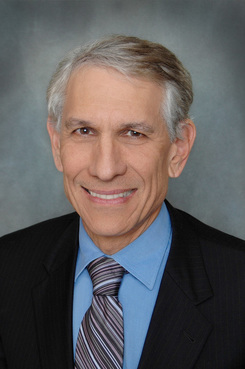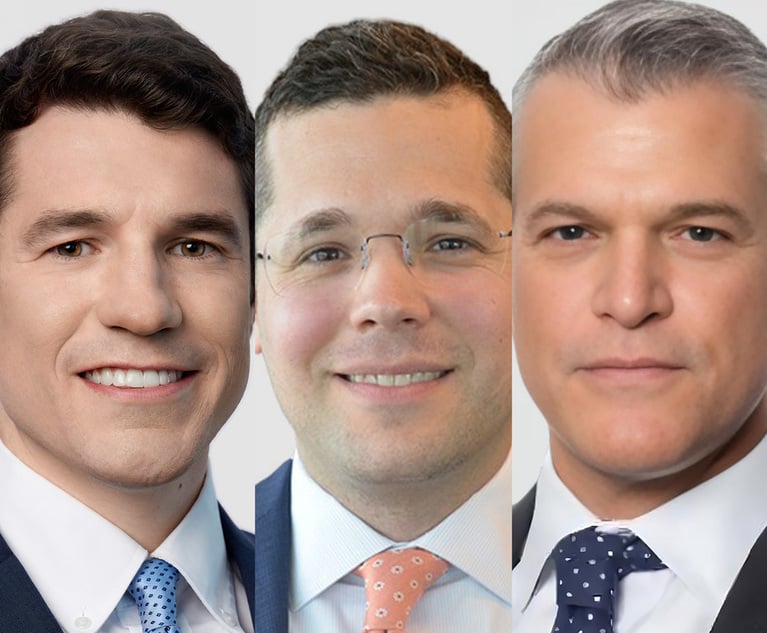Miami's Opportunity Zones Are Rife With Opportunity
The Opportunity Zone concept is receiving major attention in the real estate industry. Experts predict there will be a substantial amount of capital that will be deployed in this space in coming months.
November 15, 2018 at 09:09 AM
5 minute read
 Ronald R. Fieldstone of Saul Ewing Arnstein & Lehr.
Ronald R. Fieldstone of Saul Ewing Arnstein & Lehr.
The Opportunity Zone concept is receiving major attention in the real estate industry. Experts predict there will be a substantial amount of capital that will be deployed in this space in coming months. Earlier in 2018, after receiving recommendations from governors, the Treasury Department designated nearly 9,000 census tracts as Opportunity Zones across urban and rural areas throughout the United States (including both states and territories). It is estimated that approximately 35,000,000 Americans live in Opportunity Zones, which have higher poverty and unemployment rates than the rest of the nation.
It is not surprising that many of the locations in Opportunity Zones are economically viable for development since in many cases they are on the outskirts of an urban area that is in the process of being redeveloped. Such is the case in Downtown Miami, Florida, where there are several locations located within the fringe of the Opportunity Zones that are in the process of being developed as mixed-use projects that are literally within blocks of major existing developments. For reference purposes, the Opportunity Zones locations in Downtown Miami generally range from (East) 1st court to (West) NW 7th Avenue; (South) North River Drive to (North) NW 5th Street and from (East) Biscayne Boulevard to (West) North Miami Avenue; (South) NE 15th Street to (North) NE 17th Street.
Current projects include a substantial mixed-use project in the Wynwood area where there is a significant amount of development activity taking place already. Another project is also a mixed-use project near the new All Aboard train station complex. Several other nearby properties are also being considered for development. Outside of Downtown Miami there is a large site bear the Florida International University campus east of Biscayne Boulevard in North Miami that is ripe for Opportunity Zone development as well.
It is expected that there will be a market imbalance in that there will be more capital seeking Opportunity Zone investments than economically feasible qualifying projects available for development. It is noteworthy that some of the industry experts expect a wave of transactions during the next twelve months that will consume the Opportunity Zone pipeline in reliance upon the regulations that have just been issued.
Brief Summary of Opportunity Zone Program
In a nutshell, new Section 1400Z-2 of the Internal Revenue Code establishes several tax benefits for qualifying investments in Opportunity Zones with respect to sales or exchanges on or prior to June 29, 2027. Some of eligibility requirements include:
- An entity or an individual investor that is a partner/shareholder of an entity may defer capital gain if the investment is made within 180 days after the capital gain is realized.
- If the Opportunity Zone investment is held for at least seven years, then there is a 15 percent discount on the amount of capital gain being recognized, in addition to the deferral of the capital gain recognition until the earlier of the date of disposition of the investment or Dec. 31, 2026.
- The appreciation in the value of the Opportunity Zone project is in effect tax-free until the project is disposed of, subject to an outside limit in the year 2047.
- The Opportunity Zone property must be acquired after 2017.
- To qualify under the Opportunity Zone legislation, there must be a qualified opportunity fund (QOF) to invest capital into recognized qualified Opportunity Zone projects. The projects must be located within the designated Opportunity Zones and must be part of a qualified business, which can include both real estate and other tangible properties, including operating businesses. The funds can invest in a partnership interest and stock of a corporation or membership interests in a limited liability company, and there can be a pre-existing entity that likewise acquires the interests in the Opportunity Zone fund or becomes an Opportunity Zone fund even if it was established prior to 2018, provided that the qualifying asset is acquired after 2017.
- A QOF must invest at least 90% of its assets in qualified Opportunity Zone property, subject to variations that allow for a 70 percent investment. The basis attributable to the land component of any real estate acquisition would not be taken into account in determining whether the building has been substantially improved in order for the investment to qualify as an Opportunity Zone project.
- The new investment in the Opportunity Zone property must equal or exceed the acquisition cost of the Opportunity Zone property.
Industry experts predict that the economic value of Opportunity Zone fund investments, considering the tax advantages, will provide a significant increase in the after-tax profit from investing in an Opportunity Zone project.
Ronald R. Fieldstone is a partner in the Miami office of Saul Ewing Arnstein & Lehr. He focuses his practice on real estate, corporate/securities and taxation law.
This content has been archived. It is available through our partners, LexisNexis® and Bloomberg Law.
To view this content, please continue to their sites.
Not a Lexis Subscriber?
Subscribe Now
Not a Bloomberg Law Subscriber?
Subscribe Now
NOT FOR REPRINT
© 2025 ALM Global, LLC, All Rights Reserved. Request academic re-use from www.copyright.com. All other uses, submit a request to [email protected]. For more information visit Asset & Logo Licensing.
You Might Like
View All
Initial Steps to Set Up a Fla. Appeal: Your Future Self (or Appellate Attorney) Will Thank You
6 minute read
Divorce Timing Is Everything: Waiting for the New Year May Have Its Advantages
4 minute read
Motions for Summary Judgment and Discovery: The 2021 Rule Changes Continue to Emerge
5 minute read
Trending Stories
- 1Meta Hires Litigation Strategy Chief, Tapping King & Spalding Partner Who Was Senior DOJ Official in First Trump Term
- 2Courts Beginning to Set Standards for Evidence Relying upon Artificial Intelligence
- 3First-Degree Murder Charge May Not Fit Mangione Case
- 4Legal Tech's Predictions for Legal Ops & In-House in 2025
- 5SDNY US Attorney Damian Williams Lands at Paul Weiss
Who Got The Work
Michael G. Bongiorno, Andrew Scott Dulberg and Elizabeth E. Driscoll from Wilmer Cutler Pickering Hale and Dorr have stepped in to represent Symbotic Inc., an A.I.-enabled technology platform that focuses on increasing supply chain efficiency, and other defendants in a pending shareholder derivative lawsuit. The case, filed Oct. 2 in Massachusetts District Court by the Brown Law Firm on behalf of Stephen Austen, accuses certain officers and directors of misleading investors in regard to Symbotic's potential for margin growth by failing to disclose that the company was not equipped to timely deploy its systems or manage expenses through project delays. The case, assigned to U.S. District Judge Nathaniel M. Gorton, is 1:24-cv-12522, Austen v. Cohen et al.
Who Got The Work
Edmund Polubinski and Marie Killmond of Davis Polk & Wardwell have entered appearances for data platform software development company MongoDB and other defendants in a pending shareholder derivative lawsuit. The action, filed Oct. 7 in New York Southern District Court by the Brown Law Firm, accuses the company's directors and/or officers of falsely expressing confidence in the company’s restructuring of its sales incentive plan and downplaying the severity of decreases in its upfront commitments. The case is 1:24-cv-07594, Roy v. Ittycheria et al.
Who Got The Work
Amy O. Bruchs and Kurt F. Ellison of Michael Best & Friedrich have entered appearances for Epic Systems Corp. in a pending employment discrimination lawsuit. The suit was filed Sept. 7 in Wisconsin Western District Court by Levine Eisberner LLC and Siri & Glimstad on behalf of a project manager who claims that he was wrongfully terminated after applying for a religious exemption to the defendant's COVID-19 vaccine mandate. The case, assigned to U.S. Magistrate Judge Anita Marie Boor, is 3:24-cv-00630, Secker, Nathan v. Epic Systems Corporation.
Who Got The Work
David X. Sullivan, Thomas J. Finn and Gregory A. Hall from McCarter & English have entered appearances for Sunrun Installation Services in a pending civil rights lawsuit. The complaint was filed Sept. 4 in Connecticut District Court by attorney Robert M. Berke on behalf of former employee George Edward Steins, who was arrested and charged with employing an unregistered home improvement salesperson. The complaint alleges that had Sunrun informed the Connecticut Department of Consumer Protection that the plaintiff's employment had ended in 2017 and that he no longer held Sunrun's home improvement contractor license, he would not have been hit with charges, which were dismissed in May 2024. The case, assigned to U.S. District Judge Jeffrey A. Meyer, is 3:24-cv-01423, Steins v. Sunrun, Inc. et al.
Who Got The Work
Greenberg Traurig shareholder Joshua L. Raskin has entered an appearance for boohoo.com UK Ltd. in a pending patent infringement lawsuit. The suit, filed Sept. 3 in Texas Eastern District Court by Rozier Hardt McDonough on behalf of Alto Dynamics, asserts five patents related to an online shopping platform. The case, assigned to U.S. District Judge Rodney Gilstrap, is 2:24-cv-00719, Alto Dynamics, LLC v. boohoo.com UK Limited.
Featured Firms
Law Offices of Gary Martin Hays & Associates, P.C.
(470) 294-1674
Law Offices of Mark E. Salomone
(857) 444-6468
Smith & Hassler
(713) 739-1250






